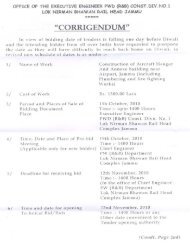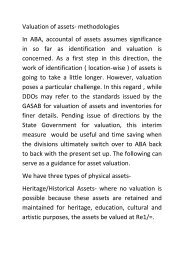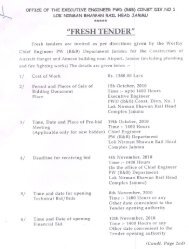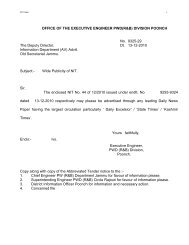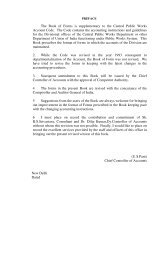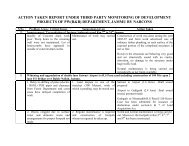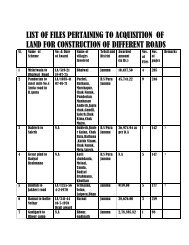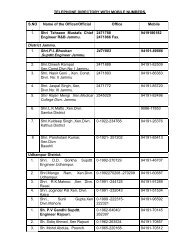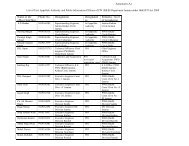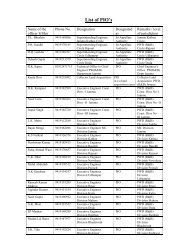Guidelines for Preparation of Financial Statements under the ...
Guidelines for Preparation of Financial Statements under the ...
Guidelines for Preparation of Financial Statements under the ...
You also want an ePaper? Increase the reach of your titles
YUMPU automatically turns print PDFs into web optimized ePapers that Google loves.
GUIDELINESFOR PREPERATIONOF FINANCIALSTATEMENTSUNDER THE ACCRUALBASIS OF ACCOUNTINGFOR IAAD1
PRESENTATION OF FINANCIAL STATEMENTSUNDER THE ACCRUAL BASIS OF ACCOUNTING IN IAAD1. ObjectiveThe objective <strong>of</strong> this standard is to prescribe <strong>the</strong> manner in whichfinancial statements should be prepared and also to ensurecomparability with <strong>the</strong> entity’s financial statements <strong>of</strong> previous period.To achieve this objective, this guidance sets out overallconsiderations <strong>for</strong> <strong>the</strong> presentation <strong>of</strong> financial statements, <strong>the</strong>irstructure, and minimum requirements <strong>for</strong> <strong>the</strong> content <strong>of</strong> financialstatements prepared <strong>under</strong> <strong>the</strong> accrual basis <strong>of</strong> accounting.2. ScopeThis standard applies to all controlled entities come <strong>under</strong> <strong>the</strong>purview <strong>of</strong> C & AG <strong>of</strong> India (Controlling entity)3. Definitions2
The following terms are used in this standard with <strong>the</strong> meaningsspecified.Accounting policies are <strong>the</strong> specific principles, bases conventions,rules and practices adopted by an entity in preparing and presentingfinancial statements.Accrual basis means a basis <strong>of</strong> accounting <strong>under</strong> which transactionsand o<strong>the</strong>r events are recognized when <strong>the</strong>y occur. It means <strong>the</strong>transactions and events are recorded in <strong>the</strong> accounting records andrecognized in <strong>the</strong> financial statements <strong>of</strong> <strong>the</strong> periods to which <strong>the</strong>yrelate. The elements recognized <strong>under</strong> accrual accounting areassets, liabilities, net assets/equity, revenue and expenses.Actuarial value Actuarial value is a ma<strong>the</strong>matical calculation,<strong>of</strong>ten <strong>of</strong> <strong>the</strong> financial condition <strong>of</strong> a pension plan. It includes <strong>the</strong>computation <strong>of</strong> <strong>the</strong> present monetary value <strong>of</strong> benefits payable topresent employees, and <strong>the</strong> present monetary value <strong>of</strong> futureemployer and employee contributions, factoring in mortality amongactive and retired members and also to <strong>the</strong> rates <strong>of</strong> disability,retirement, withdrawal from service, salary and interest. It is <strong>the</strong>value <strong>of</strong> cash, investments, and o<strong>the</strong>r property belonging to apension plan, as used by <strong>the</strong> actuary <strong>for</strong> <strong>the</strong> purpose <strong>of</strong> anactuarial valuation.Assets are resources controlled by an entityCash comprises cash on hand and demand deposits.3
Cash flows are inflows and outflows <strong>of</strong> cash.Controlled entity is an entity that is <strong>under</strong> <strong>the</strong> control <strong>of</strong> ano<strong>the</strong>rentity (known as <strong>the</strong> controlling entity) E.g., All field <strong>of</strong>fices <strong>of</strong> IAADControlling entity is an entity that has one or more controlledentities(O/o <strong>the</strong> C&AG <strong>of</strong> India)Expenses are decreases in economic benefits or service potentialduring <strong>the</strong> reporting period in <strong>the</strong> <strong>for</strong>m <strong>of</strong> outflows or consumption <strong>of</strong>assets or incurrence <strong>of</strong> liabilities that result in decreases in netassets/equity.Fair value is <strong>the</strong> amount <strong>for</strong> which an asset could be exchanged or aliability settled.Heritage Assets are those assets which are intended to bepreserved in trust <strong>for</strong> future generations because <strong>of</strong> <strong>the</strong>ir cultural,environmental or historical associations. (e.g., Historical buildings)Liabilities are present obligations <strong>of</strong> <strong>the</strong> entity, <strong>the</strong> settlement <strong>of</strong>which is expected to result in an outflow <strong>of</strong> resources from <strong>the</strong> entityembodying economic benefits or service potential.Net assets/equity is <strong>the</strong> residual interest in <strong>the</strong> assets <strong>of</strong> <strong>the</strong> entityafter deducting all its liabilities. It may be positive or negative.4
Net surplus/deficit is comprised <strong>of</strong> <strong>the</strong> following components:a) surplus or deficit from ordinary activities; andb) Extra-ordinary items.Ordinary activities are any activities which are <strong>under</strong>taken by anentity as part its service delivery or trading activities viz., Running <strong>of</strong>Departmental canteen.Surplus/deficit from ordinary activities is <strong>the</strong> residual amount thatremains after expenses arising from ordinary activities have beendeducted from revenue arising from ordinary activities.Segment is a distinguishable activity or group <strong>of</strong> activities <strong>of</strong> an entity<strong>for</strong> which it is appropriate to separately report financial in<strong>for</strong>mation <strong>for</strong><strong>the</strong> purpose <strong>of</strong> evaluating <strong>the</strong> entity’s past per<strong>for</strong>mance in achievingits objectives and <strong>for</strong> making decisions about <strong>the</strong> future allocation <strong>of</strong>resources.Reporting date means <strong>the</strong> date <strong>of</strong> <strong>the</strong> last day <strong>of</strong> <strong>the</strong> reporting periodto which <strong>the</strong> financial statements relate i.e., 31.3.2010 <strong>for</strong> <strong>the</strong>financial period 2009 -10Reporting currency is <strong>the</strong> currency used in presenting <strong>the</strong> financialstatements. It is to be reported in thousands <strong>of</strong> rupees.5
4. Purpose <strong>of</strong> <strong>Financial</strong> <strong>Statements</strong><strong>Financial</strong> statements are a structured representation <strong>of</strong> <strong>the</strong> financialposition <strong>of</strong> and <strong>the</strong> transactions <strong>under</strong>taken by an entity during <strong>the</strong>reporting period. They provide in<strong>for</strong>mation about <strong>the</strong> sources and how<strong>the</strong> entity utilized <strong>the</strong>ir allocation etc. Generally, <strong>the</strong> financialstatements provide in<strong>for</strong>mation about an entity’s;a) Assets;b) Liabilities;c) Net assets/equity;d) Revenue;e) Expenses; andf) Cash flows.5. Responsibility <strong>for</strong> <strong>Financial</strong> <strong>Statements</strong>The responsibility <strong>for</strong> <strong>the</strong> preparation <strong>of</strong> <strong>the</strong> financial statements <strong>of</strong> afield <strong>of</strong>fice rests with <strong>the</strong> head <strong>of</strong> an entity or AccountantGeneral/Principal Accountant General6. Components <strong>of</strong> <strong>Financial</strong> <strong>Statements</strong>A complete set <strong>of</strong> financial statements includes <strong>the</strong> followingcomponents:6
(a) Statement <strong>of</strong> financial position or Balance sheet or statement <strong>of</strong>assets and liabilities(b) Statement <strong>of</strong> financial per<strong>for</strong>mance or Expenditure Statement<strong>of</strong> an entity <strong>for</strong> <strong>the</strong> reporting period(c) Segment Reporting(d) Accounting policies and Notes to <strong>the</strong> financial statements. Thenotes to <strong>the</strong> financial statements may also include “schedules’.7. <strong>Guidelines</strong> <strong>for</strong> preparation and presentation <strong>of</strong> financialstatements7.1. Statement <strong>of</strong> <strong>Financial</strong> Position / Balance Sheet orStatement <strong>of</strong> Assets and LiabilitiesThe face <strong>of</strong> <strong>the</strong> statement <strong>of</strong> financial position should include <strong>the</strong> lineitems as detailed below are broad in nature. Each item may be subclassified,when appropriate, by its nature. An entity should disclose,ei<strong>the</strong>r on <strong>the</strong> face <strong>of</strong> <strong>the</strong> expenditure statement or in <strong>the</strong> notes to <strong>the</strong>statement <strong>of</strong> financial position, fur<strong>the</strong>r sub-classifications <strong>of</strong> <strong>the</strong> lineitems presented, classified in <strong>the</strong> manner appropriate to <strong>the</strong> entity’soperations, as set out in <strong>the</strong> guidelines.7.1.1. AssetsTangible Assets - Land & Buildings - The value <strong>of</strong> such propertyshould be disclosed, and <strong>the</strong> method <strong>of</strong> valuation (cost, valuation ornominal) should be clearly stated. At <strong>the</strong> end <strong>of</strong> <strong>the</strong> financial period<strong>the</strong> inventory value at <strong>the</strong> beginning and end <strong>of</strong> <strong>the</strong> financial period<strong>of</strong> non-expendable equipment, furniture and motor vehicles should bedisclosed and <strong>the</strong> method <strong>of</strong> valuation (cost or valuation) should beclearly stated in a note to <strong>the</strong> financial statements. Additions and7
disposals made during <strong>the</strong> financial period should also be disclosed.Impairment reviews are <strong>under</strong>taken <strong>for</strong> all assets at least annually.The costs incurred during construction which extend over more thanone financial period should be accumulated and disclosed in aseparate account. Separate disclosure should be made <strong>of</strong> <strong>the</strong>amounts and timing <strong>of</strong> commitments <strong>for</strong> acquisition <strong>of</strong> land orbuildingsIntangible Assets – S<strong>of</strong>tware- These are stated at fair market valueless accumulated amortization and any impairment losses.Amortization is provided over <strong>the</strong> estimated useful life using <strong>the</strong>straight line method at <strong>the</strong> rate <strong>of</strong> depreciation <strong>of</strong> 20%.Method <strong>of</strong> valuation: Property (o<strong>the</strong>r than Land & Buildings) andEquipment are stated at fair market value cost less accumulateddepreciation and any impairment losses.Depreciation is provided <strong>for</strong> Property & Equipment over <strong>the</strong>irestimated useful life using <strong>the</strong> straight line method (at <strong>the</strong> rate <strong>of</strong>20%), except <strong>for</strong> land which is not subject to depreciation. In respect<strong>of</strong> <strong>the</strong> building, a nominal value based on <strong>the</strong> age <strong>of</strong> <strong>the</strong> building maybe adopted as prescribed by <strong>the</strong> norms <strong>of</strong> Registration Department<strong>of</strong> <strong>the</strong> respective State Government.Estimated useful life (years).Tangible AssetsUseful life(years)8
Buildings Permanent 40Buildings Temporary 5Computer Equipment 5Office Equipment 5Office fixtures & fittings 5Security & safety equipment 5Telecommunication equipment 5Motor Vehicles 5Intangible AssetsS<strong>of</strong>tware acquired externally 5Internally developed s<strong>of</strong>tware 5Licenses, Rights and Copyrights onintangible assets5The following Line Items are to be reported in <strong>the</strong> Assets7.1.1.1. Heritage Assets – The financial value increasing in nature tobe reflected in <strong>the</strong> balance sheet has to be derived from a marketprice even if <strong>the</strong>ir physical condition deteriorates.7.1.1.2. Land and Buildings – The total extent <strong>of</strong> land owned by <strong>the</strong>entity has been valued based on <strong>the</strong> guideline rates prescribed by <strong>the</strong>respective Government bodies, i.e., Rates prescribed by <strong>the</strong>Registration Department.9
The value <strong>of</strong> <strong>the</strong> building may be arrived at considering <strong>the</strong> age<strong>of</strong> <strong>the</strong> building. In respect <strong>of</strong> <strong>the</strong> building aged more than 50 years, anominal value <strong>of</strong> Rs.1/ per sqft may be adopted without providing anydepreciation. In all o<strong>the</strong>r cases, <strong>the</strong> value <strong>of</strong> <strong>the</strong> building may bearrived at based on <strong>the</strong> guideline rates prescribed by <strong>the</strong> Governmentbodies after applying appropriate depreciation.7.1.1.3. Furniture & Fittings – The value has to be arrived afterapplying depreciation over <strong>the</strong> asset’s estimated useful life usingstraight line method <strong>of</strong> 20% depreciation.7.1.1.4. Computers & related equipment - The value has to bearrived after applying depreciation over <strong>the</strong> asset’s estimated usefullife using straight line method <strong>of</strong> 20% depreciation.7.1.1.5. Vehicles - The value has to be arrived after applyingdepreciation over <strong>the</strong> asset’s estimated useful life using straight linemethod <strong>of</strong> 20% depreciation.7.1.1.6. Advances made to staff – Advances to staff viz., Festivaladvance, MCA/Scooter/Cycle Advance, House Building Advance,Computer Advance, Fan Advance made during <strong>the</strong> reporting periodrecoverable in <strong>the</strong> <strong>for</strong>m <strong>of</strong> equal monthly instalments are to bereflected in <strong>the</strong> balance sheet as assets.7.1.1.7. Advances made to o<strong>the</strong>rs – The Pre-paid credits availablein <strong>the</strong> franking machine used <strong>for</strong> postage stamps are reflectedagainst this item.10
7.1.1.8. Cash balance & Deposits – The Cash in hand is to beshown.7.1.1.9 Revenue Account – Opening Balance & Revenue <strong>for</strong> <strong>the</strong>current year to be added.7.1.2. Liabilities7.1.2.1 Capital Account – The consolidated figure <strong>of</strong> land andbuildings, furniture and fittings, Computers and related equipments(after applying depreciation) has to be shown against this item in <strong>the</strong>balance sheet.7.1.2.2. Capital Account – Reserves & Surplus Canteen – Some <strong>of</strong><strong>the</strong> field <strong>of</strong>fices may run Departmental canteen. Their accounts aregenerally prepared on pr<strong>of</strong>it and loss account basis. In such cases,Reserve and Surplus depicted in <strong>the</strong>ir annual accounts are shownagainst this item.7.1.2.3. Pension Liability (Actuarial basis) – The anticipated averagepension payable <strong>for</strong> <strong>of</strong>fice employees <strong>for</strong> <strong>the</strong> next 30 years has to beshown as pension liability. The average has to be worked out basedon <strong>the</strong> pension paid to retired employees in <strong>the</strong> past three years.7.1.2.4. Salaries and employees entitlements payable – Salariesand entitlements payable to employees pertaining to <strong>the</strong> month <strong>of</strong>11
march every year (to be paid in April <strong>of</strong> next financial year) have to beshown as liability <strong>for</strong> <strong>the</strong> current financial year7.1.2.5. Payable to o<strong>the</strong>rs – The telephone & electricity chargesrelated to march every year (to be paid in <strong>the</strong> month <strong>of</strong> April <strong>of</strong> nextfinancial year) have to be shown against this item.7.2. Statement <strong>of</strong> <strong>Financial</strong> per<strong>for</strong>mance or ExpenditureStatement – Segment ReportingThe Expenditure statement should include comparative in<strong>for</strong>mation <strong>of</strong>actual expenditure with <strong>the</strong> budgeted amounts as well as with <strong>the</strong>previous year actuals. This may be prepared by using a columnar<strong>for</strong>mat, with separate columns <strong>for</strong> budgeted amounts (BudgetEstimate, FMA) and actual amounts <strong>for</strong> <strong>the</strong> current year and previousyear, as shown in <strong>the</strong> Appendix I, in order to facilitate <strong>for</strong> makingassessments <strong>of</strong> an entity’s ability and also influence decisions aboutresources to be allocated to <strong>the</strong> entity in <strong>the</strong> future.An entity should present an analysis <strong>of</strong> expenses using aclassification based on ei<strong>the</strong>r <strong>the</strong> nature <strong>of</strong> expenses or <strong>the</strong>irfunctions within <strong>the</strong> entity, as appropriate Expenses are aggregatedin <strong>the</strong> statement according to <strong>the</strong>ir nature, <strong>for</strong> example salaries,wages and depreciation, purchases <strong>of</strong> materials,12
In respect <strong>of</strong> Audit <strong>of</strong>fices viz. Civil Audit and Commercial & ReceiptAudit Departments, <strong>the</strong> segment reporting may be prepared based on<strong>the</strong> types <strong>of</strong> audit being <strong>under</strong>taken e.g., Scheme Review,Per<strong>for</strong>mance Audit, IT Audit, Excise audit, Expenditure audit etc or on<strong>the</strong> basis <strong>of</strong> areas <strong>of</strong> audit like Public works, Commercial, Civil,Revenue etc. The expenditure may be apportioned to each type <strong>of</strong>audit ei<strong>the</strong>r based on <strong>the</strong> total mandays <strong>of</strong> audit or based on <strong>the</strong>number <strong>of</strong> audits per<strong>for</strong>med during <strong>the</strong> year.7.2.1. As a minimum, <strong>the</strong> face <strong>of</strong> <strong>the</strong> statement <strong>of</strong> financialper<strong>for</strong>mance should include line items which present <strong>the</strong>following amounts:• Net Salaries = (Salaries + Unpaid salaries – Prepaid Salaries– Previous year’s salaries)• Wages – Include Contract employees, Private Security charges& House keeping• Honorarium• Medical expenses towards employees• Leave Travel Concession• Net Travel Expenses (Travel expenses + unpaid travelexpenses – Travel advance and adjustment <strong>of</strong> previousyear’s travel expenses)• Overtime Allowance• Stationary include Local printing <strong>of</strong> <strong>for</strong>ms• Electricity and Water Charges include Hot & Cold wea<strong>the</strong>rcharges• Rent, Rates and Taxes• Telephone, Telegram and Service Postage Stamps• Publications include purchases <strong>of</strong> Books & periodicals in Hindi• Repairs and o<strong>the</strong>r minor maintenance works to buildings –(Minor works)• Grants-in-aid13
• Pr<strong>of</strong>essional Service charges include expenditure related toISO certification, Legal Charges to Advocates.• Depreciation• Depreciation in Buildings• Miscellaneous expenditure on computers and relatedequipment include AMCs, Purchase <strong>of</strong> Computer accessories /Consumables• Revenue pr<strong>of</strong>it /revenue loss <strong>of</strong> Departmental canteen, ifapplicable• Pension expenses• O<strong>the</strong>r miscellaneous expenses include Liveries <strong>of</strong> Group D,Repairs to furniture, Staff car/Two wheeler, Water Coolers,o<strong>the</strong>r <strong>of</strong>fice machineries & misc. <strong>of</strong>fice expenditure.• Revenue expenses <strong>of</strong> <strong>of</strong>fice• Revenue earned during <strong>the</strong> year• Net Revenue expense transferred to Revenue Account(Revenue expense – Revenue earned during <strong>the</strong> year)7.3. Segment Reporting DetailsThe expenses associated with <strong>the</strong> main functions or classificationsare fur<strong>the</strong>r sub-classified and shown separately in <strong>the</strong> SegmentReporting – Details.Entities classifying expenses should disclose additional supportingin<strong>for</strong>mation viz., measurement basis (or bases), depreciation applied<strong>for</strong> items presented on <strong>the</strong> face <strong>of</strong> <strong>the</strong> financial statement in <strong>the</strong> orderin which each line item is presented in this statement and as well asNotes to <strong>the</strong> financial statements in <strong>the</strong> <strong>for</strong>m <strong>of</strong> detailed schedules.14
7.3.1. Salaries and o<strong>the</strong>r entitlements <strong>of</strong> staff viz,: Honorarium,Medical expenses towards employees, Leave Travel Concession,Travel Expenses, Overtime Allowance may be apportioned amongvarious groups <strong>of</strong> entity based on <strong>the</strong> men-in-position in each group.Expenses relate to Repairs and o<strong>the</strong>r minor maintenance works tobuildings and o<strong>the</strong>r miscellaneous expenses may also be apportionedamong various groups based on <strong>the</strong> same factor cited ibid.7.3.2. Expenses relate to Stationary, Telephone, Telegram andService Postage Stamps, Publications, Pr<strong>of</strong>essional service chargesand Grants-in-aid may be apportioned based on <strong>the</strong> availability <strong>of</strong>men-in-position in each group.7.3.3. Expenses relate to Electricity and Water Charges, Rent, Ratesand Taxes may be apportioned based on <strong>the</strong> area occupied by eachgroup <strong>of</strong> <strong>the</strong> entity.7.3.4. Wages paid to casual employees engaged towards securitypurposes and departmental canteen contract employees may beapportioned evenly among all groups.7.3.5. The expenditure related to Computer and its related equipmentmay be apportioned based on <strong>the</strong> availability <strong>of</strong> number <strong>of</strong> PCs ineach group.7.3.6. Revenue pr<strong>of</strong>it and revenue loss <strong>of</strong> Departmental canteen -Departmental canteen exists in some <strong>of</strong> <strong>the</strong> field <strong>of</strong>fices. Theiraccounts are generally prepared on pr<strong>of</strong>it and loss account basis. Insuch cases, Revenue pr<strong>of</strong>it and revenue loss <strong>of</strong> Departmental15
• Take <strong>the</strong> three years (2007‐08, 2008‐09 and 2009‐10) actualpension amount disbursed and <strong>the</strong> number <strong>of</strong> pensioners in an excelsheet.• Highlight <strong>the</strong> three values and pull down <strong>for</strong> ano<strong>the</strong>r 27 yearswhich will work out <strong>the</strong> values in <strong>the</strong> geometric progression.• Assess <strong>the</strong> average pensioners. 1400 has been determined in<strong>the</strong> example. Average <strong>the</strong> values calculated in 2 above to <strong>the</strong>determined number <strong>of</strong> pensioners , which will give <strong>the</strong> valueper pensioner per year from which <strong>the</strong> value <strong>of</strong> <strong>the</strong> liability onpension can be calculated.Or• Take <strong>the</strong> value <strong>of</strong> <strong>the</strong> current expenses and use <strong>the</strong> netpresent value function available in <strong>the</strong> Excel sheet to calculate<strong>the</strong> value <strong>of</strong> pension liability <strong>for</strong> <strong>the</strong> next 30 years. The <strong>for</strong>mulawould be :=NPV(8,0,D50)*30/1000=NPV(8,0, 130487597)*30/1000.8 is Discounted rate, 0 is <strong>the</strong> income which is nil and <strong>the</strong>third parameter is <strong>the</strong> current year expenses. 30 isexpanded <strong>for</strong> ano<strong>the</strong>r 30 years and divided by 1000 tohave <strong>the</strong> values in ‘000 in <strong>the</strong> income and expenditure17
7.4. Notes to <strong>the</strong> Accounts - (N)<strong>Financial</strong> statements should include as Note 1 a statement <strong>of</strong> <strong>the</strong>organization’s objectives. <strong>Financial</strong> statements should include clearand concise disclosure <strong>of</strong> all significant accounting policies whichhave been used <strong>for</strong> proper <strong>under</strong>standing <strong>of</strong> <strong>the</strong> financial statements.These policies should be disclosed in Note 2 to <strong>the</strong> financialstatements, with cross-references as necessary to individualstatements (Refer 7.3). The Notes to <strong>the</strong> Accounts may includeSchedules which exhibits additional supportive in<strong>for</strong>mation <strong>of</strong> lineitems..The contents to be included in <strong>the</strong> notes to <strong>the</strong> Accounts areillustrated below <strong>for</strong> guidance.7.4.1. Organization objectives – The entity named as ‘O/o <strong>the</strong>Accountant General ……….., State is headed by <strong>the</strong> AccountantGeneral. The functions <strong>of</strong> <strong>the</strong> entity are:….…..The entity is located at ………………(361, Anna Salai, Teynampet,Chennai 600018) and its complement is approximately 1591 staffmembers.7.4.2. Significant Accounting policies18
• The financial statements <strong>of</strong> O/o <strong>the</strong> AccountantGeneral……have been prepared on <strong>the</strong> accrual basis <strong>of</strong>accounting in accordance with <strong>the</strong> International Public SectorAccounting Standards - (IPSAS)• These are <strong>the</strong> first set <strong>of</strong> financial statements to be prepared onaccrual basis <strong>of</strong> accounting. The following accounting policieshave been adopted <strong>for</strong> <strong>the</strong> preparation <strong>of</strong> financial statements.• Accounts are prepared annually• Comparative in<strong>for</strong>mation has been provided in <strong>the</strong> Statement <strong>of</strong><strong>Financial</strong> Per<strong>for</strong>mance.• Initial recognition <strong>of</strong> equipments purchased be<strong>for</strong>e 31 st March2009 at <strong>the</strong> cost <strong>of</strong> acquisition less accumulated depreciation,where <strong>the</strong> assets had more than 5 years remaining useful life.• <strong>Financial</strong> statements are presented in thousands <strong>of</strong> rupees(Indian Rupees).• Depreciation is provided <strong>for</strong> Property & Equipment over <strong>the</strong>irestimated useful life using <strong>the</strong> straight line method (at <strong>the</strong> rate<strong>of</strong> 20%), except <strong>for</strong> land which is not subject to depreciation. Inrespect <strong>of</strong> <strong>the</strong> building, a nominal value based on <strong>the</strong> age <strong>of</strong> <strong>the</strong>building may be adopted as prescribed by <strong>the</strong> norms <strong>of</strong>Registration Department <strong>of</strong> <strong>the</strong> respective State Government.• Cash and Cash equivalents are held at nominal value andcomprise cash on hand• Provisions are made <strong>for</strong> future liabilities viz., Pension Liability• Impairment reviews are <strong>under</strong>taken <strong>for</strong> all assets annually• Post Employment Benefits – are defined benefit plansconsisting Pension as well as Family pension to <strong>the</strong> retiredemployees. Contributory Pension Scheme introduced in <strong>the</strong>year 2004 <strong>for</strong> those employees who joined service on or after1.1.0.2004. Provisions will be made after <strong>for</strong>mulatingaccounting policies by <strong>the</strong> Controlling entity <strong>for</strong> CPS.• Head <strong>of</strong> Department (Accountant General) <strong>of</strong> <strong>the</strong> entity iscompetent authority to write <strong>of</strong>f losses and to make ex-gratiapayments. During <strong>the</strong> Reporting period, no losses were written<strong>of</strong>fand no ex-gratia payments made.• The reporting date is 31 st March <strong>of</strong> <strong>the</strong> financial year.• There are no contingent liabilities arising from legal actions andclaims that are likely to result in a significant liability to this<strong>of</strong>fice.19
7.4.3. An entity may also disclose sub-classifications and transactions<strong>of</strong> <strong>the</strong> line items presented in <strong>the</strong> financial statements (detailed inPara 7.3.) in <strong>the</strong> Notes to <strong>the</strong> Accounts with cross reference to <strong>the</strong>financial statement.7.4.4. Schedules - (S)Additional supporting in<strong>for</strong>mation <strong>for</strong> items presented on <strong>the</strong> face <strong>of</strong><strong>the</strong> financial statement may be provided in <strong>the</strong> <strong>for</strong>m <strong>of</strong> Schedules withcross-reference to individual line item <strong>of</strong> financial statements (may beexhibited as S1,S2, S3 etc.) <strong>for</strong> <strong>the</strong> proper <strong>under</strong>standing <strong>of</strong> users.Specimen schedules prepared in <strong>the</strong> o/o <strong>the</strong> Accountant General…………… may please refer to, <strong>for</strong> guidance.7.4.4.1. Registers to be maintained electronicallyTo facilitate <strong>the</strong> preparation <strong>of</strong> financial statements includingSchedules, Registers to be maintained electronically on annual basis<strong>for</strong> each <strong>of</strong> <strong>the</strong> individual line item as appropriate, in <strong>the</strong> followingcolumnar <strong>for</strong>mat.(E.g., Asset Register <strong>for</strong> both Tangible and Intangible)Opening BalanceAdditions during <strong>the</strong> reporting periodTotalDisposedDepreciation20
Closing Balance7.5. APPENDIX IIllustrative <strong>Financial</strong> structure in Excel FormatTake Print out <strong>of</strong> <strong>the</strong> following:1. Statement <strong>of</strong> <strong>Financial</strong> Position2. Statement <strong>of</strong> <strong>Financial</strong> Per<strong>for</strong>mance or Expenditure Statement3. Segment Reporting4. Schedules (1 -23)NOTE: All <strong>the</strong> sheets have been individually closed with a password. Hence <strong>the</strong> cell having <strong>for</strong>mula islocked. The sheet named details has cells in which <strong>the</strong> data has to be entered. These cells which are notlocked will automatically take <strong>the</strong> data to <strong>the</strong> concerned sheet. The password <strong>for</strong> every sheet is “accrual”.Where ever <strong>the</strong> data has to be entered <strong>the</strong> same is in unlocked position to automatically enter <strong>the</strong> data.21



